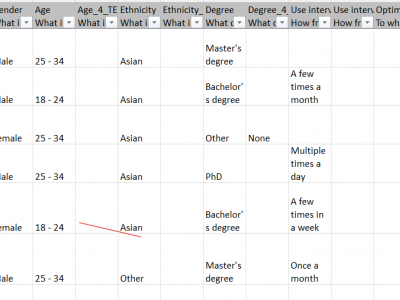*.csv

NAND Flash-based Synthetic Block IO traces from FIO benchmark is focused on understanding characteristics of flash memoy under various access patterns. The dataset comprises distinct seven wrorkloads.
Workoad 1 and 2 are sequential write workloads. Workload 1 represents the typical seuqential write pattern, while Workload 2 represents partioning sequential write pattern, dividing 8 logical partitions.
Workload 3 and 4 are random write workloads. Workload 3 follows a uniform random distribution, and Worklod 4 follows the Zipfian random distribution with a theta of 0.8.
- Categories:
 36 Views
36 ViewsPlease cite the following paper when using this dataset:
N. Thakur, S. Cui, K. A. Patel, N. Azizi, V. Knieling, C. Han, A. Poon, and R. Shah, “Marburg Virus Outbreak and a New Conspiracy Theory: Findings from a Comprehensive Analysis and Forecasting of Web Behavior,” Journal of Computation, Vol. 11, Issue. 11, Article. 234, Nov. 2023, DOI: http://dx.doi.org/10.3390/computation11110234
Abstract
- Categories:
 223 Views
223 Views
The Integrated Energy Management and Forecasting Dataset is a comprehensive data collection specifically designed for advanced algorithmic modeling in energy management. It combines two distinct yet complementary datasets - the Energy Forecasting Data and the Energy Grid Status Data - each tailored for different but related purposes in the energy sector.
- Categories:
 4139 Views
4139 ViewsThe poor posture is one of the main common health problems in the growth of adolescents, which seriously affects their physical and mental health. The posture gait recognition is a premise for preventing and correcting the poor posture. This paper proposes a gait recognition method for poor posture based on PCA-BP neural network. Using wearable intelligent insoles to measure plantar pressure, a gait recognition model based on PCA-BP neural network model is constructed.
- Categories:
 529 Views
529 Views
The VNA dataset has three features: frequency, S21, and phase, while the MIMO dataset has an additional 'Channel' feature. The VNA dataset is larger than the MIMO dataset, with 507,709 rows compared to 164,161 rows in the MIMO dataset. This is because the VNA dataset was sampled at a 1 MHz resolution, while the MIMO dataset was sampled at a 25 MHz resolution, which is the limit set by the MATLAB API. As a result, the VNA dataset provides 4,701 samples per tag, while the MIMO dataset provides 190 samples per tag per channel for each reading.
- Categories:
 122 Views
122 Views
This dataset is collected to benchmark different software algorithms for UWB indoor localization. The dataset is collected in a controlled environment with mm-accurate groundtruth to evaluate different algorithms. The data is collected with the Wi-Pos UWB system,a platform developed for research data collection with a wireless long-range Sub-GHz backbone combined with UWB ranging based on the DW1000. The UWB is configured with a center frequency of 6489.6 MHz, a bandwidth of 499.2 MHz (channel 5) and a preamble length of 1024 symbols.
- Categories:
 310 Views
310 Views
The first Algerian forest fires dataset consist of data on forest fires occurrence in Algeria related to meteorological observations and the fire weather indices. Our dataset includes mainly the daily meteorological observations and the Fire Weather Index (FWI) system components. Given the lack of publically available datasets on data on forest fires occurrence in Algeria we have created this one to study the feasibility of the appliance of machine learning algorithms as models for forest fires prediction in the context of Algeria.
- Categories:
 1130 Views
1130 Views
Normal
0
21
false
false
false
CS
X-NONE
X-NONE
- Categories:
 72 Views
72 Views
We collected relevant data of ultrasonic Doppler flowmeter in the laboratory to study the error of ultrasonic Doppler flowmeter. It contains four sets of data at different turbidities and four sets of data at different liquid levels. Each set of data under different turbidities contains 440 pieces of data, and each set of experiments under different liquid levels contains 220 pieces of data. The entire data set has a total of 2720 pieces of data. The training set test split is 8:2, which we have already split in the uploaded data set.
- Categories:
 83 Views
83 Views

